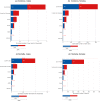Forecasting Head and Neck Cancer Trends in GCC Countries: Implications for Public Health Policy and Strategy
- PMID: 38164292
- PMCID: PMC10758177
- DOI: 10.2147/RMHP.S445162
Forecasting Head and Neck Cancer Trends in GCC Countries: Implications for Public Health Policy and Strategy
Abstract
Purpose: The data available on the incidence and mortality rates of head and neck cancer types (HNCs) in the Gulf Cooperation Council countries (GCC) have relied on global trends and covered only certain cancer sites, types or certain age groups. This study aimed to assess the incidence and mortality rates of head and neck cancer (HNCs) within the Gulf Cooperation Council (GCC) countries, providing insights into their geographic variability in 2020.
Methods: Prediction of the magnitude of the disease to 2040 was explored based on demographic projections. Estimates of incidence and mortality and the population projections were extracted from the Global Cancer Observatory (GLOBOCAN) database and the United Nations Department of Economic and Social Affairs respectively for the time frame 2020 to 2040. Additionally, we analyzed the distribution of cases and deaths by age and sex for both time periods.
Results: The analysis indicates varying patterns in HNC rates across GCC countries in 2020, with Oman and Saudi Arabia carrying the highest burden. Projections for 2040 reveal a substantial increase in new HNC cases and related deaths, particularly in Qatar, UAE, and Bahrain. Furthermore, incidence rates are predicted to rise significantly for individuals aged 50 and older, while remaining relatively stable for those under 50. With regards to sex, males generally exhibit higher rates, except in Qatar.
Conclusion: HNC burden is anticipated to rise significantly in the GCC, with variations per age, sex and geographical location. By 2040, a 2-3-fold increase in HNCs in the GCC is anticipated, emphasizing the need for focused public health strategies to address this rising health challenge.
Keywords: cancer prevention; globocan; head and neck neoplasms; projection.
© 2023 Alsharif et al.
Conflict of interest statement
The authors report no conflicts of interest in this work.
Figures



Similar articles
-
Influence of Age on 2040 Cancer Burden in the Older Population of the Gulf Cooperation Council (GCC) Countries: Public Health Implications.Cancer Control. 2021 Jan-Dec;28:10732748211027158. doi: 10.1177/10732748211027158. Cancer Control. 2021. PMID: 34486405 Free PMC article.
-
Hemodialysis delivery, dialysis dose achievement, and vascular access types in hemodialysis patients from the Gulf Cooperation Council countries enrolled in the dialysis outcomes and practice patterns study phase 5 (2012-2015).Saudi J Kidney Dis Transpl. 2016 Nov;27(6 Suppl 1):S42-50. doi: 10.4103/1319-2442.194889. Saudi J Kidney Dis Transpl. 2016. PMID: 27991478
-
Ecological study of breast cancer incidence among nationals and nonnationals in the Gulf Cooperation Council countries.East Mediterr Health J. 2023 Jan 19;29(1):40-48. doi: 10.26719/emhj.23.005. East Mediterr Health J. 2023. PMID: 36710613
-
Progress of the Gulf Cooperation Council (GCC) Countries Towards Achieving the 95-95-95 UNAIDS Targets: A Review.J Epidemiol Glob Health. 2023 Sep;13(3):397-406. doi: 10.1007/s44197-023-00097-1. Epub 2023 Apr 20. J Epidemiol Glob Health. 2023. PMID: 37079171 Free PMC article. Review.
-
Current Epidemiological Characteristics of Imported Malaria, Vector Control Status and Malaria Elimination Prospects in the Gulf Cooperation Council (GCC) Countries.Microorganisms. 2021 Jul 2;9(7):1431. doi: 10.3390/microorganisms9071431. Microorganisms. 2021. PMID: 34361867 Free PMC article. Review.
Cited by
-
Factors influencing engagement in oral cancer prevention activities among dental students and professionals in Saudi Arabia.BMC Oral Health. 2024 Dec 4;24(1):1465. doi: 10.1186/s12903-024-05266-7. BMC Oral Health. 2024. PMID: 39633404 Free PMC article.
References
-
- GCC Statistical Center (GCC-STAT). GCC statistical atlas; 2018. Available from: GCC_ATLAS_2020_V7_17_Nov_2020_2.pdf (gccstat.org). Accessed December 22, 2023.
-
- Shayah MH, Sun Z. Employment in the Gulf Cooperation Council (GCC) countries – current issues and future trends. International Conference on Social Science, Public Health and Education (SSPHE 2018). 2019:412–415
-
- The Economist: Economist Intelligence Unit. The GCC in 2020: the gulf and its people.; 2020.
LinkOut - more resources
Full Text Sources

